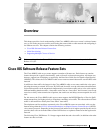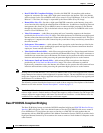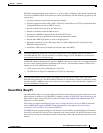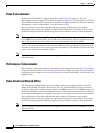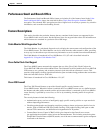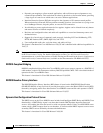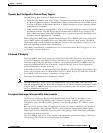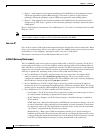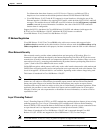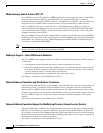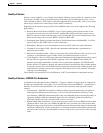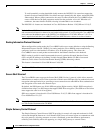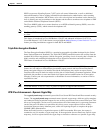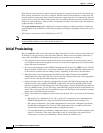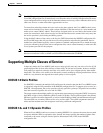
1-8
Cisco uBR924 Software Configuration Guide
OL-0337-05 (8/2002)
Chapter 1 Overview
Cisco IOS Software Release Feature Sets
• Phase 1—Adds support for the alternate gatekeeper field (altGKInfo) to the gatekeeper rejection
(GRJ) and registration rejection (RRJ) messages. This allows a gateway to move between
gatekeepers during the gatekeeper request (GRQ) and registration request (RRQ) phases.
• Phase 2—Adds support for the alternate gatekeeper field (altGKInfo) to the admission rejection
(ARJ) message. This allows a gateway to move between gatekeepers during the admission request
(ARQ) phase.
Phase 1 of this feature is introduced in Cisco IOS Release 12.1(1)T. Phase 2 is introduced in Cisco IOS
Release 12.1(2)T.
Note For more information on this feature, see the Ecosystem Gatekeeper Interoperability Enhancements,
Phase 2 feature module, available on CCO and the Documentation CD-ROM.
Fax over IP
Fax over IP is a form of VoIP support that supports the unique characteristics of fax transmissions. When
using a voice-enabled image, the two voice ports on the Cisco uBR924 router can be connected to either
fax machines or voice telephones, allowing fax traffic to be sent as VoIP traffic.
This feature is introduced in Cisco IOS Software Release 12.0(5)T.
H.323v2 (Gateway/Gatekeeper)
The Cisco uBR924 cable access router can support VoIP traffic as an H.323v2 gateway. The H.323v2
protocol maps an IP address to an E.164 telephone number, allowing VoIP calls to terminate either on
other VoIP devices or on devices in the regular telco network. The H.323v2 protocol uses a dial plan and
mapper on a server located at the CMTS or elsewhere to perform this mapping, which can be done either
statically or dynamically, depending on the version of Cisco IOS software being used.
• In Cisco IOS Release 12.0(4)XI1 or higher images, the service provider can configure the IP
addresses statically using the voip dial peer group command. The service provider can also
configure the telephone numbers attached to the Cisco uBR924 cable access router by configuring
the IP addresses statically using the CLI pots port command.
• In Cisco IOS Release 12.0(5)T or higher images, the service provider can obtain IP addresses
dynamically from a Cisco gatekeeper using Registration, Admission, and Status (RAS). The service
provider can also dynamically obtain telephone IP addresses using Cisco Network Registrar (CNR).
• Cisco IOS Release 12.1(1)T adds a number of H.323v2 features:
–
Fast Connect—This H.323v2 feature allows connections for the most common types of calls to
be created without establishing a separate H.245 control channel.
–
H.245 Tunneling—Supports two H.245 features during a call without having to establish an
H.245 channel:
DTMF digit relay—Dual-tone multifrequency (DTMF) tones are often used during a voice call
to convey information, such as entering an account number voicemail commands. Certain forms
of compression (such as G.729) might interfere with these tones, so they must be transmitted
“out of band,” separated from the encoded voice stream.
Hookflash relay—Many types of PBX and telephone switches give a special meaning to a
hookflash (quickly depressing and releasing the hook on your telephone). Because this creates
a voltage change that cannot be transmitted across an IP network, the H.323 protocol can send
an H.245 User Input Indication message to convey the hookflash to the remote end.




